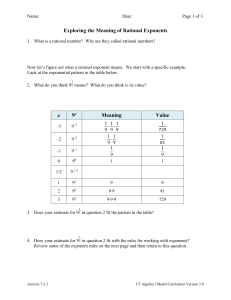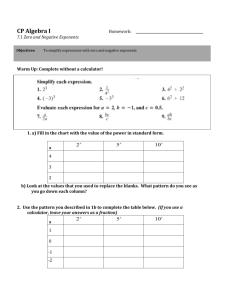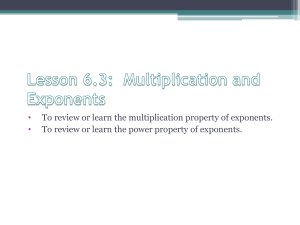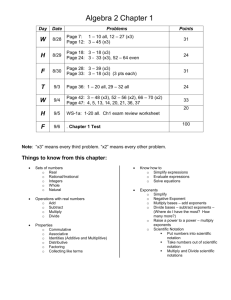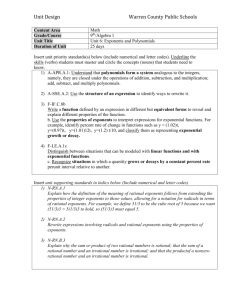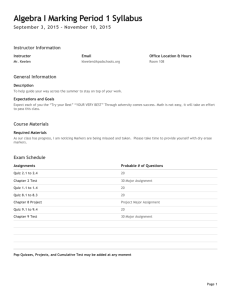Algebra 1 Unit: 3
advertisement
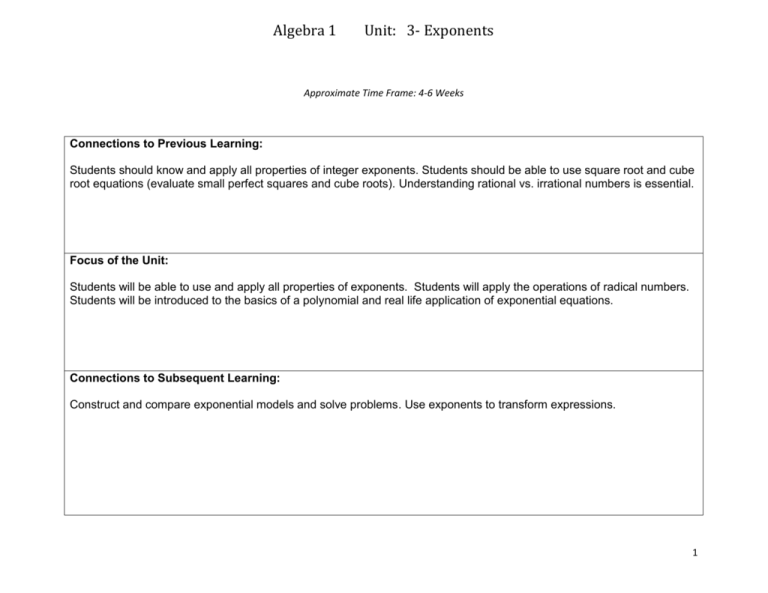
Algebra 1 Unit: 3- Exponents Approximate Time Frame: 4-6 Weeks Connections to Previous Learning: Students should know and apply all properties of integer exponents. Students should be able to use square root and cube root equations (evaluate small perfect squares and cube roots). Understanding rational vs. irrational numbers is essential. Focus of the Unit: Students will be able to use and apply all properties of exponents. Students will apply the operations of radical numbers. Students will be introduced to the basics of a polynomial and real life application of exponential equations. Connections to Subsequent Learning: Construct and compare exponential models and solve problems. Use exponents to transform expressions. 1 Algebra 1 Unit: 3- Exponents Desired Outcomes Standard(s): A.SSE. 1a Interpret parts of an expression, such as terms, factors and coefficients N.RN. 1 Extend the properties of integer exponents to explain the definition of the meaning of rational exponents. N.RN. 2 Rewrite expressions involving radicals and rational exponents using property of exponents N.RN. 3 Explain why the sum or product of two rational numbers is rational; that the sum of a rational number and irrational number is irrational and that the product of a nonzero rational number and an irrational number is irrational. F.BF. 1a Determine an explicit expression, a recursive process or steps for calculation from a context. F.BF. 1b Combine standard function types using arithmetic operations F.IF. 8b Use the properties of exponents to interpret expressions for exponential functions. F.LE. 3 Construct and compare exponential models and solve problems A.REI. 11 Alter and predict rates and outcomes from given data A.SSE. 1b Interpret complicated expressions by viewing one or more of their parts as a single entity A.SSE. 3c Use the properties of exponents to transform expressions for exponential functions F.LE. 2 Construct and compare exponential models and solve problems Priority Standards Supporting Standards Additional Standards Transfer: Students will apply… 2 Algebra 1 Unit: 3- Exponents Understandings: Students will understand that… Essential Questions: 3 Algebra 1 Unit: 3- Exponents Highlighted Mathematical Practices: (Practices to be explicitly emphasized are indicated with an *.) 1. Make sense of problems and persevere in solving them. Students demonstrate their ability to persevere by selecting a modality to begin representing their understanding (i.e manipulatives, pictures). They can work collaboratively to represent their measurements or quantities and discuss their representations. 2. Reason abstractly and quantitatively. Students will demonstrate their abstract and quantitative reasoning by estimating lengths and then refining their estimates based upon new information. They also demonstrate reasoning by explaining indirect measurements. They need to use measurement units correctly – understanding that the smaller the unit, the more units you need to measure a given object. 3. Construct viable arguments and critique the reasoning of others. Students will explain why they chose to represent a quantity or measurement in a particular way. They will also listen to each other and explain what their peers have said. 4. Model with mathematics. In this unit, students are asked to transfer between manipulative, number line, drawings and other visual representations. They are asked to explain in words how their visuals are representing measurements or quantities. 5. Use appropriate tools strategically. Students demonstrate their ability to use non-standard measurement units to measure lengths of objects. Hey need to select the correct tools and know when a number line is an appropriate representation. 6. Attend to precision. Students demonstrate precision by using comparison language appropriately to describe their measurements and quantities. They count precisely to measure accurately. 7. Look for and make use of structure. Students demonstrate the ability to use structure in their graphs, ten frames and on the 120 chart. Students can use these structures to explain the patterns and answer questions about measurements and quantities. 8. Look for express regularity in repeated reasoning. When students note patterns on, and can use the 10 frames, 120 chart and graphs to solve problems or create new representations, they are using their repeated reasoning. 4 Algebra 1 Unit: 3- Exponents Prerequisite Skills/Concepts: Advanced Skills/Concepts: Students should already be able to… Some students may be ready to… Knowledge: Students will know… Skills: Students will be able to… 5 Algebra 1 Unit: 3- Exponents WIDA Standard: English Language Learners English language learners communicate information, ideas and concepts necessary for academic success in the content area of Mathematics. English language learners would benefit from: Academic Vocabulary: Critical Terms: Supplemental Terms: 6 Algebra 1 Unit: 3- Exponents Assessment Pre-Assessments Formative Assessments Summative Assessments Self-Assessments Sample Lesson Sequence 7
